Flamenco
Flamenco (Spanish pronunciation: [flaˈmeŋko]), in its strictest sense, is an art form based on the various folkloric music traditions of southern Spain in the autonomous community of Andalusia and Murcia. In a wider sense, the term is used to refer to a variety of Spanish musical styles. The oldest record of flamenco music dates to 1774 in the book Las Cartas Marruecas by José Cadalso (Akombo 2016, 240–241). Flamenco has been influenced by and associated with the Romani people in Spain; however, its origin and style are uniquely Andalusian (Hayes 2009, 31–37).
| Flamenco | |
|---|---|
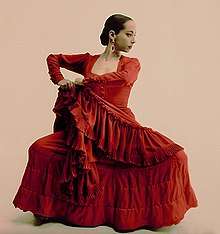 Flamenco dancer with traditional dress | |
| Cultural origins | Andalusia, Spain |
| Typical instruments |
|
| Subgenres | |
| New flamenco | |
| Fusion genres | |
| Flamenco chill | |
| Other topics | |
| |
Manuel Ríos Ruiz notes that the development of flamenco is well documented: "the theatre movement of sainetes (one-act plays) and tonadillas, popular song books and song sheets, customs, studies of dances, and toques, perfection, newspapers, graphic documents in paintings and engravings....in continuous evolution together with rhythm, the poetic stanzas, and the ambiance" (Ríos Ruiz 1997, ).
Nevertheless, the exact origin of flamenco is unknown and the subject of many hypotheses. The most widespread is that flamenco was developed through the cross-cultural interchange between moriscos and gitanos (Romani people of Spain) during the sixteenth century specifically in East Andalusia (Machin-Autenrieth 2015, 29); the Diccionario de la lengua española (Dictionary of the Spanish Language) primarily attributes the creation of the style directly to the Spanish Romani (Real Academia Española 2019, sense 4).
Flamenco has become popular all over the world, especially the United States and Japan. In Japan, there are more flamenco academies than there are in Spain (Mendoza 2011, 52). "In El Salvador the group Alma Flamenca is considered the maximum representative and pioneer of this musical movement" (Mendoza 2011, 52).
On November 16, 2010, UNESCO declared flamenco one of the Masterpieces of the Oral and Intangible Heritage of Humanity (Anon. 2010).
Etymology
There are many suggestions for the origin of the word flamenco as a musical term, but no solid evidence for any of them. The word is Spanish for "Flemish" (meaning "native of Flanders", a one-time Spanish possession) (Harper n.d.). The Spanish verb flamear means to flambé. The word was not recorded as a musical and dance term until the late 18th century, in the book Las Cartas Marruecas by José Cadalso (1774) (Akombo 2016, 240–241).
One theory, proposed by Andalusian historian Blas Infante, is that the word is derived from the Hispano-Arabic term fellah mengu, meaning "expelled peasant", referring to the Andalusians of Islamic faith and the remaining Moriscos who fled with the Roma newcomers (Infante 2010, 166; Herrera 2006).
Another theory is that the Spanish word flamenco is a derivative of the Spanish word, meaning "fire" or "flame". The word flamenco may have been used for fiery behaviour, which could have come to be applied to the Gitano players and performers (Ruiz 2007, 165ff).
Palos

Palos (formerly known as cantes) are flamenco styles, classified by criteria such as rhythmic pattern, mode, chord progression, stanzaic form and geographic origin. There are over 50 different palos, some are sung unaccompanied while others have guitar or other accompaniment. Some forms are danced while others are not. Some are reserved for men and others for women while some may be performed by either, though these traditional distinctions are breaking down: the Farruca, for example, once a male dance, is now commonly performed by women too.
There are many ways to categorize Palos but they traditionally fall into three classes: the most serious is known as cante jondo (or cante grande), while lighter, frivolous forms are called cante chico. Forms that do not fit either category are classed as cante intermedio (Pohren 2005, 68). These are the best known palos (Anon. 2019; Anon. 2012):
- Alegrías
- Bulerías
- Bulerías por soleá (soleá por bulerías)
- Caracoles
- Cartageneras
- Fandango
- Fandango de Huelva
- Fandango Malagueño
- Farruca
- Granaínas
- Guajiras
- Malagueñas
- Martinete
- Mineras
- Nanas
- Peteneras
- Rondeñas
- Saeta
- Seguiriyas
- Soleá
- Tangos
- Tanguillos
- Tarantos
- Tientos
- Villancicos
Music
There are three fundamental elements which can help define whether or not something really is flameco: A flamenco mode -or musical tonality-; the compás -rhythm- and the performer...who should be a Flamenco! All three of these elements: tonality, compás, a flamenco performer and then something less easily identifiable- Flamencura- must be present together if we are to wend up with a piece of music which can be labelled 'flamenco'. By themselves, these elements won't turn a piece of music into flamenco.
— (Martinez 2011, 6)
Three fundamental elements that help define whether or not a dance belongs to the Flamenco genre are the presence of a Flamenco mode (musical tonality), compas, and a Flamenco performer (Martinez, 2003). These three elements contribute to the authenticity of a Flamenco performance also known as flamencura (Martinez, 2003). There is also no such thing as a passive audience during Flamenco performances [participatory music]. The audience joins in the performance by clapping their hands and even sometimes singing along (Totton, 2003).
— (Akombo 2016, 243)
Structure
A typical flamenco recital with voice and guitar accompaniment comprises a series of pieces (not exactly "songs") in different palos. Each song is a set of verses (called copla, tercio, or letras), punctuated by guitar interludes (falsetas). The guitarist also provides a short introduction setting the tonality, compás (see below) and tempo of the cante (Manuel 2006, 98). In some palos, these falsetas are played with a specific structure too; for example, the typical sevillanas is played in an AAB pattern, where A and B are the same falseta with only a slight difference in the ending (Martin 2002, 48).
Harmony
Flamenco uses the Flamenco mode (which can also be described as the modern Phrygian mode (modo frigio), or a harmonic version of that scale with a major 3rd degree), in addition to the major and minor scales commonly used in modern Western music. The Phrygian mode occurs in palos such as soleá, most bulerías, siguiriyas, tangos and tientos.
A typical chord sequence, usually called the "Andalusian cadence" may be viewed as in a modified Phrygian: in E the sequence is Am–G–F–E (Manuel 2006, 96). According to Manolo Sanlúcar E is here the tonic, F has the harmonic function of dominant while Am and G assume the functions of subdominant and mediant respectively (Torres Cortés 2001).
Guitarists tend to use only two basic inversions or "chord shapes" for the tonic chord (music), the open 1st inversion E and the open 3rd inversion A, though they often transpose these by using a capo. Modern guitarists such as Ramón Montoya, have introduced other positions: Montoya himself started to use other chords for the tonic in the modern Dorian sections of several palos; F♯ for tarantas, B for granaínas and A♭ for the minera. Montoya also created a new palo as a solo for guitar, the rondeña in C♯ with scordatura. Later guitarists have further extended the repertoire of tonalities, chord positions and scordatura.
There are also palos in major mode; most cantiñas and alegrías, guajiras, some bulerías and tonás, and the cabales (a major type of siguiriyas). The minor mode is restricted to the Farruca, the milongas (among cantes de ida y vuelta), and some styles of tangos, bulerías, etc. In general traditional palos in major and minor mode are limited harmonically to two-chord (tonic–dominant) or three-chord (tonic–subdominant–dominant) progressions (Rossy 1998, 92). However modern guitarists have introduced chord substitution, transition chords, and even modulation.
Fandangos and derivative palos such as malagueñas, tarantas and cartageneras are bimodal: guitar introductions are in Phrygian mode while the singing develops in major mode, modulating to Phrygian at the end of the stanza (Rossy 1998, 92).
Melody
Dionisio Preciado, quoted by Sabas de Hoces (1982, ), established the following characteristics for the melodies of flamenco singing:
- Microtonality: presence of intervals smaller than the semitone.
- Portamento: frequently, the change from one note to another is done in a smooth transition, rather than using discrete intervals.
- Short tessitura or range: Most traditional flamenco songs are limited to a range of a sixth (four tones and a half). The impression of vocal effort is the result of using different timbres, and variety is accomplished by the use of microtones.
- Use of enharmonic scale. While in equal temperament scales, enharmonics are notes with identical pitch but different spellings (e.g. A♭ and G♯); in flamenco, as in unequal temperament scales, there is a microtonal intervalic difference between enharmonic notes.
- Insistence on a note and its contiguous chromatic notes (also frequent in the guitar), producing a sense of urgency.
- Baroque ornamentation, with an expressive, rather than merely aesthetic function.
- Apparent lack of regular rhythm, especially in the siguiriyas: the melodic rhythm of the sung line is different from the metric rhythm of the accompaniment.
- Most styles express sad and bitter feelings.
- Melodic improvisation: flamenco singing is not, strictly speaking, improvised, but based on a relatively small number of traditional songs, singers add variations on the spur of the moment.
Musicologist Hipólito Rossy adds the following characteristics (Rossy 1998, 97):
- Flamenco melodies are characterized by a descending tendency, as opposed to, for example, a typical opera aria, they usually go from the higher pitches to the lower ones, and from forte to piano, as was usual in ancient Greek scales.
- In many styles, such as soleá or siguiriya, the melody tends to proceed in contiguous degrees of the scale. Skips of a third or a fourth are rarer. However, in fandangos and fandango-derived styles, fourths and sixths can often be found, especially at the beginning of each line of verse. According to Rossy, this is proof of the more recent creation of this type of songs, influenced by Castilian jota.
Compás
Compás is the Spanish word for metre or time signature (in classical music theory). It also refers to the rhythmic cycle, or layout, of a palo.
The compás is fundamental to flamenco. Compás is most often translated as rhythm but it demands far more precise interpretation than any other Western style of music. If there is no guitarist available, the compás is rendered through hand clapping (palmas) or by hitting a table with the knuckles. The guitarist uses techniques like strumming (rasgueado) or tapping the soundboard (golpe). Changes of chords emphasize the most important downbeats.
Flamenco uses three basic counts or measures: Binary, Ternary and a form of a twelve-beat cycle that is unique to flamenco. There are also free-form styles including, among others, the tonás, saetas, malagueñas, tarantos, and some types of fandangos.
- Rhythms in 2
4 or 4
4. These metres are used in forms like tangos, tientos, gypsy rumba, zambra and tanguillos. - Rhythms in 3
4. These are typical of fandangos and sevillanas, suggesting their origin as non-Roma styles, since the 3
4 and 4
4 measures are not common in ethnic Roma music. - 12-beat rhythms usually rendered in amalgams of 6
8 + 3
4 and sometimes 12
8. The 12-beat cycle is the most common in flamenco, differentiated by the accentuation of the beats in different palos. The accents do not correspond to the classic concept of the downbeat. The alternating of groups of 2 and 3 beats is also common in Spanish folk dances of the 16th Century such as the zarabanda, jácara and canarios.
There are three types of 12-beat rhythms, which vary in their layouts, or use of accentuations: soleá, seguiriya and bulería.
- peteneras and guajiras: 1 2 3 4 5 6 7 8 9 10 11 12. Both palos start with the strong accent on 12. Hence the meter is 12 1 2 3 4 5 6 7 8 9 10 11...
- The seguiriya, liviana, serrana, toná liviana, cabales: 121 2 3 4 5 6 7 8 9 10 11 12.
- soleá, within the cantiñas group of palos which includes the alegrías, cantiñas, mirabras, romera, caracoles and soleá por bulería (also "bulería por soleá"): 1 2 3 4 5 6 7 8 9 10 11 12. For practical reasons, when transferring flamenco guitar music to sheet music, this rhythm is written as a regular 3
4.
The Bulerías is the emblematic palo of flamenco: today its 12-beat cycle is most often played with accents on the 3rd, 6th, 8th, 10th and 12th beats. The accompanying palmas are played in groups of 6 beats, giving rise to a multitude of counter-rhythms and percussive voices within the 12 beat compás. In certain regions like, Xerez, Spain, the rhythm stays in a simpler six-count rhythm, only including the twelve count in a musical resolve.
Forms of flamenco expression
Toque (guitar)
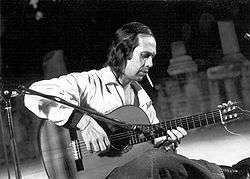
The origins, history and importance of the flamenco guitar is covered in the main Wikipedia entry for the Flamenco guitar.
Cante (song)

The origins, history and importance of the cante is covered in the main Wikipedia entry for the cante flamenco.
Baile (dance)
El baile flamenco is known for its emotional intensity, proud carriage, expressive use of the arms and rhythmic stamping of the feet, unlike tap dance or Irish dance which use different techniques. As with any dance form, many different styles of flamenco have developed.
In the twentieth century, flamenco danced informally at gitano (Roma) celebrations in Spain was considered the most "authentic" form of flamenco. There was less virtuoso technique in gitano flamenco, but the music and steps are fundamentally the same. The arms are noticeably different from classical flamenco, curving around the head and body rather than extending, often with a bent elbow.
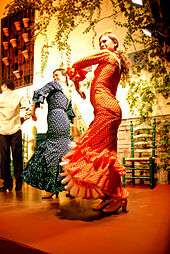
"Flamenco puro" otherwise known as “flamenco por derecho” is considered the form of performance flamenco closest to its gitano influences. In this style, the dance is often performed solo, and is based on signals and calls of structural improvisation rather than choreographed. In the improvisational style, castanets are not often used.
"Classical flamenco" is the style most frequently performed by Spanish flamenco dance companies. It is danced largely in a proud and upright style. For women, the back is often held in a marked back bend. Unlike the more gitano influenced styles, there is little movement of the hips, the body is tightly held and the arms are long, like a ballet dancer. In fact many of the dancers in these companies are trained in Ballet Clásico Español more than in the improvisational language of flamenco. Flamenco has both influenced and been influenced by Ballet Clásico Español, as evidenced by the fusion of the two ballets created by 'La Argentinita' in the early part of the twentieth century and later, by Joaquín Cortés, eventually by the entire Ballet Nacional de España et al.
In the 1950s Jose Greco was one of the most famous male Flamenco dancers, performing on stage worldwide and on television including the Ed Sullivan Show, and reviving the art almost singlehandedly. Greco's company left a handful of prominent pioneers, most notably: Maria Benitez and Vicente Romero of New Mexico. Today, there are many centers of Flamenco art. Albuquerque, New Mexico is considered the “Center of the Nation” for Flamenco Art. Much of this is due to Maria Benitez's 37 years of sold-out summer seasons. Albuquerque boasts three distinct prominent centers: National Institute of Flamenco, Casa Flamenca and Flamenco Works. Each center dedicates time to daily training, cultural diffusion and world-class performance equaled only to world-class performances one would find in the heart of Southern Spain, Andalucía.
Modern flamenco is a highly technical dance style requiring years of study. The emphasis for both male and female performers is on lightning-fast footwork performed with absolute precision. In addition, the dancer may have to dance while using props such as castanets, canes, shawls and fans.
"Flamenco nuevo" is a recent marketing phenomenon in Flamenco. Marketed as a “newer version” of Flamenco, its roots came from world-music promoters trying to sell albums of artists who created music that “sounded like” or had Spanish-style influences. Though some of this music was played in similar pitches, scales and was well-received, it has little to nothing to do with the Art of Flamenco guitar, dance, cante Jondo or the improvisational language. “Nuevo Flamenco” consists largely of compositions and repertoire, while Traditional Flamenco music and dance is a language composed of stanzas, actuated by oral formulaic calls and signals.
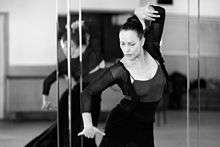
The flamenco most foreigners are familiar with is a style that was developed as a spectacle for tourists. To add variety, group dances are included and even solos are more likely to be choreographed. The frilly, voluminous spotted dresses are derived from a style of dress worn for the Sevillanas at the annual Feria in Seville.
In traditional flamenco, only the very young or older dancers are considered to have the emotional innocence or maturity to adequately convey the duende (soul) of the genre (Anon. n.d.). Therefore, unlike other dance forms, where dancers turn professional through techniques early on to take advantage of youth and strength, many flamenco dancers do not hit their peak until their thirties and will continue to perform into their fifties and beyond. One artist that is considered a young master is Juan Manuel Fernandez Montoya, otherwise known as “Farruquito.” At age 12, Farruquito was considered a pioneer and for “Flamenco Puro,” or “Flamenco por Derecho,” because of his emotional depth.
 Claudio Castelucho, Flamenco
Claudio Castelucho, Flamenco José Villegas Cordero, Baile Andaluz
José Villegas Cordero, Baile Andaluz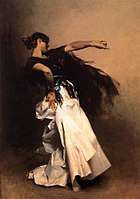 John Singer Sargent, Spanish Dancer
John Singer Sargent, Spanish Dancer
- Scenes of flamenco performance in Seville.
See also
- Andalusian Centre of Flamenco – an institution in Spain founded in 1993 to safeguard and promote the values and standards of flamenco
- Concurso de Cante Jondo – (Contest of the Deep Song) was a fiesta of flamenco arts, music, song, and dance, held in Granada in 1922
- Festival Bienal Flamenco – in theatres Seville, this festival features flamenco puro to innovative new works by dancers, vocalists and guitarists
- Flamenco rumba – a style of flamenco music
- Flamenco rock – a rock music subgenre that emerged from Andalusia
- Flamenco shoes – commonly leather shoes constructed with small nails embedded in the toe and heel to enhance the sound of the dancer's percussive footwork
- Latin Grammy Award for Best Flamenco Album
- Kumpanía: Flamenco Los Angeles – a 2011 independent documentary film exploring the origins and contemporary Spanish culture of flamenco
- New Flamenco – a derivative of traditional flamenco fusing flamenco guitar virtuosity with other musical styles
- Camarón de la Isla – considered one of the all-time greatest flamenco singers
- Paco de Lucia – a Spanish virtuoso flamenco guitarist, composer, and record producer
- David Peña Dorantes – a Romani flamenco pianist and composer from Andalusia
- Niño Josele – a Spanish guitarist, and exponent of the New flamenco style
- Paco Peña – regarded as one of the world's foremost traditional flamenco guitar players
- Sevillanas – a type of folk music and dance of Seville and its region, influenced by flamenco
- Silverio Franconetti – a singer and the leading figure of the period in flamenco history known as "The Golden Age"
- Tablao – a place where flamenco shows are performed and the term used for the flamenco dance floor
- Tomatito – a Spanish roma flamenco guitarist
- Traje de flamenca – the dress traditionally worn by women at festivals in Andalusia; one form worn by dancers
- María Pagés – a modern Spanish dancer and choreographer, considered the paramount representative of flamenco vanguard
- Cristina Hoyos – a Spanish flamenco dancer, choreographer and actress who played an important role during the opening and closing ceremonies of the 1992 Summer Olympics in Barcelona
- Vicente Amigo – a Spanish flamenco composer and guitarist
- Antoñita Singla – a Catalonian flamenco dancer and actress known as "La Singla" who took Spain and Europe by storm in the period 1960-1988.
Sources
- Akombo, David (2016). The Unity of Music and Dance in World Cultures. North Carolina: McFarland Books. ISBN 978-0786497157.CS1 maint: ref=harv (link)
- Álvarez Caballero, Ángel: El cante flamenco, Alianza Editorial, Madrid, Second edition, 1998. ISBN 84-206-9682-X (First edition: 1994)
- Álvarez Caballero, Ángel: La Discografía ideal del cante flamenco, Planeta, Barcelona, 1995. ISBN 84-08-01602-4
- Anon. 2010. "El flamenco es declarado Patrimonio Cultural Inmaterial de la Humanidad por la Unesco", Yahoo Noticias, 16 November 2010 (accessed 16 November 2010).
- Anon. "Palos & compas ". Flamenco-Events.com (2012; accessed 19 March 2020).
- Anon. "Palos del Flamenco: Categorías". flamencoexport.com (2019, accessed 19 March 2020).
- Arredondo Pérez, Herminia, and Francisco J. García Gallardo, : "Música flamenca. Nuevos artistas, antiguas tradiciones" In Andalucía en la música. Expresión de comunidad, construcción de identidad, edited by Francisco J. García y Herminia Arredondo. Sevilla: Centro de Estudios Andaluces, 2014, pp. 225–242. ISBN 978-84-942332-0-3
- Banzi, Julia Lynn (Ph.D.): "Flamenco Guitar Innovation and the Circumscription of Tradition" 2007, 382 pages; AAT 328581, DAI-A 68/10, University of California, Santa Barbara.
- Caba Landa, Pedro, and Carlos Caba Landa. Andalucía, su comunismo y su cante jondo. First edition, Editorial Atlántico 1933. Third edition, Editorial Renacimiento 2008. ISBN 978-84-8472-348-6
- Coelho, Víctor Anand (Editor): "Flamenco Guitar: History, Style, and Context", in The Cambridge Companion to the Guitar, Cambridge University Press, 2003, pp. 13–32.
- García Lorca, Federico. "El cante jondo (Primitivo canto andaluz)". In
- Harper, Douglas. "flamenco". Online Etymology Dictionary..
- Hayes, Michelle Heffner (2009). Flamenco: Conflicting Histories of the Dance. North Carolina: McFarland Books. ISBN 978-0786439232.CS1 maint: ref=harv (link)
- Herrera, Muhammad Ali (March 2006). "Breve biografía de Blas Infante". Alif Nûn (36). Archived from the original on 2013-04-11.CS1 maint: ref=harv (link)
- Hoces Bonavilla, Sabas de. n.d. "Acotaciones sobre algunos conceptos errados con el flamenco (1)". funjdiaz.net. Retrieved 2019-10-22. Revista de Folklore, no. 23:147–157 (archive from 24 September 2015).
- Infante, Blas (2010). Orígenes de lo Flamenco y Secreto del Cante Jondo (1929–1933) (PDF). Consejería de Cultura de la Junta de Andalucía. p. 166.CS1 maint: ref=harv (link)
- Koster, Dennis (1 June 2002). Guitar Atlas, Flamenco. Alfred Music Publishing. ISBN 978-0-7390-2478-2. Retrieved 4 March 2013.CS1 maint: ref=harv (link)
- Machin-Autenrieth, Matthew (2015). "Flamenco ¿Algo Nuestro? (Something of Ours?): Music, Regionalism and Political Geography in Andalusia, Spain". Ethnomusicology Forum. 24 (1 (April)): 4–27. doi:10.1080/17411912.2014.966852.CS1 maint: ref=harv (link)
- Mairena, Antonio, and Ricardo Molina. Mundo y formas del cante flamenco, Librería Al-Ándalus, third edition, 1979 (First Edition: Revista de Occidente, 1963)
- Martin, Juan (2002). Solo Flamenco Guitar. Mel Bay Publications. p. 48. ISBN 978-0-7866-6458-0.CS1 maint: ref=harv (link)
- Martinez, Emma (2011). Flamenco: All You Wanted to Know. Mel Bay. ISBN 9781609744700.CS1 maint: ref=harv (link).
- Martín Salazar, Jorge: Los cantes flamencos, Diputación Provincial de Granada, Granada, 1991 ISBN 84-7807-041-9
- Manuel, Peter. "Flamenco in Focus: An Analysis of a Performance of Soleares." In Analytical Studies in World Music, edited by Michael Tenzer. New York: Oxford University Press, 2006, pp. 92–119.
- Mendoza, Gabriela. "Ser flamenco no es una música, es un estilo de vida". El Diario de Hoy (2011): .
- Ortiz Nuevo, José Luis: Alegato contra la pureza, Libros PM, Barcelona, 1996. ISBN 84-88944-07-1
- Pohren, Donn E. The Art of Flamenco. Westport, Connecticut: Bold Strummer, 2005. ISBN 978-0933224025.
- Real Academia Española. "flamenco, ca". Diccionario de la lengua Española, tricentenary edition. Madrid: Real Academia Español, 2019. (accessed 19 March 2020).
- Ríos Ruiz, Manuel. Ayer y hoy del cante flamenco, Ediciones Istmo, Tres Cantos (Madrid), 1997. ISBN 84-7090-311-X.
- Rossy, Hipólito: Teoría del Cante Jondo, Cresda, Barcelona, 1998. ISBN 84-7056-354-8 (First edition: 1966)
- Ruiz, Ana (2007). Vibrant Andalusia: The Spice of Life in Southern Spain. Algora. ISBN 978-0-87586-540-9.CS1 maint: ref=harv (link)
- Torres Cortés, Norberto. "El compromiso y la generosidad de manolo Sanlúcar ". El Olivo, no. 88 (February 2001, especial "Manolo Sanlúcar").
%2C_Martin_Style_3-17_(1859)_-_C.F._Martin_Guitar_Factory_2012-08-06_-_011.jpg)